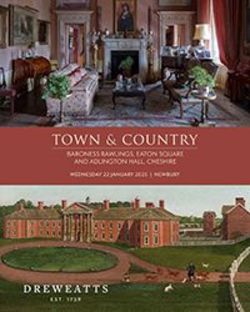AN ELIZABETHAN REVIVAL OAK HALF-TESTER BED
CIRCA 1860
The tester with an urn finial and boldly carved strapwork apron, pendants and brackets above a panel of modern Flemish tapestry and a four panel headboard with foliate and strapwork cresting and centred by a winged mask, the footboard with barley-twist columns and centred by a mask of Queen Elizabeth I above a cartouche, the square panelled posts with ball finials
270cm high, 158cm wide, 210cm long
Provenance:
Probably acquired by Charles Richard Banastre Legh (1821-88) for Adlington Hall, Cheshire, possibly as part of a refurbishment of the mansion, and thence by descent.
Literature:
Adlington Guide Book: 'No 10 Bedroom' 'Jacobean Oak Half Tester Bed, c. 1860. The four panel headboard is contained by a canopy with boldly carved strapwork details, while the footboard has twist turned columns and is centred by a mask of Queen Elizabeth above a vacant cartouche'.
This impressive Elizabethan-Revival bed is a fine example of antiquarian taste fashionable in the 19 th century. The bed offered here is enriched with heavy historicist carving liberally applied to the cornice, head-board and bottom of a half tester of a 19 th century double bed. 19 th century decorative art dealers supplied original antique furniture and pastiche furniture to meet an increasing demand by collectors interested in the relics of the past, and who wanted to emphasize the antiquity of their family lineage. One of the most prolific dealer/cabinet-makers was George Shaw (1810-76), a Yorkshire architect, who had an early interest in ancient beds (P. Lindfield, 'George Shaw Revisited: Ancient Oak and Beds', FHS Newsletter 225, February 2022, pp. 2-12). In the early 1840s, Shaw began to create 'modern' pastiches of antique furniture offering what he variously described as 'Henry VIII', Elizabeth I or 'James I', including a tester bed to which he added a footboard and royal arms that he sold to James Deardon (1798-1862) of Rochdale Manor, and, in 1847, the well-documented carved 'Paradise' bed, made for the Duke of Northumberland (sold 'Syon Park, Sotheby's, 14-16 May 1997, lot 197, and again, Christie's, London, 25 November 2004, lot 142).
As early as 1811, it was noted that 'young fellows of the better classes, in Paris' were 'ornamenting their bed-chambers and particularly their bed's head, with arms and armour of all kinds' (C. Edwards, The Romantic Interior: the British Collector at home 1750-1850, London and New Haven, 1989, p. 63). This historicist style was probably inspired by drawings of state beds in A. W. N. Pugin's, Gothic Furniture in the Style of the Fifteenth Century (1835), pl. 11, and Henry Shaw's Specimens of Ancient Furniture drawn from existing authorities, London, 1836, which included four antique beds: The Great Bed of Ware, an Elizabethan bed, now in the Victoria & Albert Museum (W.47:1 to 28-1931), two 17 th century beds from Goodrich Court and a bed from Hardwicke Hall, Derbyshire (plates XXXVII, XXXVIII, XXXIX, XL). In the official catalogue of the 1851 Exhibition, the furniture exhibits were respectively described as Elizabethan, Tudor, Gothic, Louis XIV, Renaissance, Italian, Arabian and Old English Illuminated style (R.W. Symonds, Victorian Furniture, London, 1987, p. 35). Designs for half tester beds in the antiquarian style were subsequently included in Art industry: furniture, upholstery, and house-decoration, illustrative of the arts of the carpenter, joiner, cabinet-maker, painter, decorator, and upholsterer (1879), ed. by G.W. Yapp, an Assistant Commissioner and Compiler of the Official Catalogues of the Great Exhibition of 1851, who on describing a bed in the 1851 exhibition noted: 'It is a State bed in the Elizabethan style, but judiciously treated in a lighter manner than is common' (Symonds, ibid., plates 17, 22). In 1857, the state bedroom at Abney Hall, Cheshire, was refurbished probably by J.G. Crace (1809-89) in the antiquarian style to mark the visit of the Prince Consort to the Manchester Art Treasures Exhibition that year (E. Aslin, 19 th Century Furniture, New York, 1962, plate 73).
Condition Report:
There are the inevitable minor dents marks and scratches and shrinkage cracks due to age and use.
Condition Report Disclaimer














